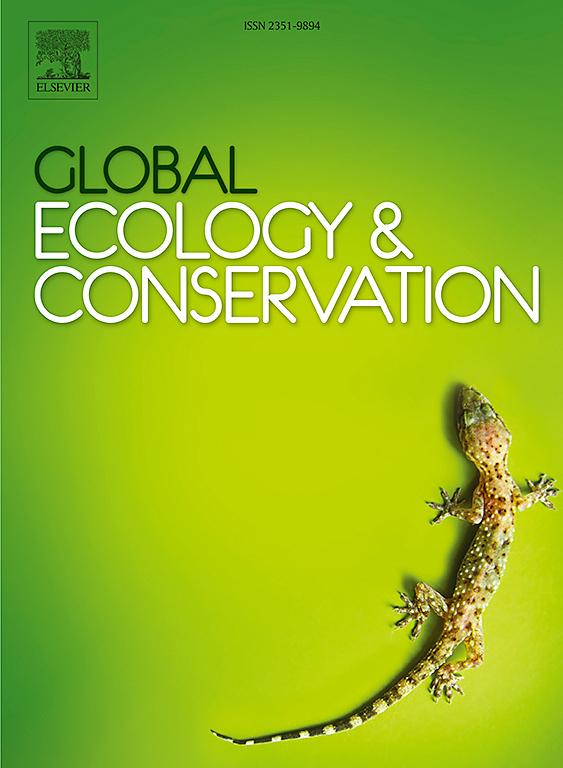山林木本树苗的海拔适应和分布:来自功能性状和菌根关联的见解
IF 3.5
2区 环境科学与生态学
Q1 BIODIVERSITY CONSERVATION
引用次数: 0
摘要
尽管树苗的适应策略尚不清楚,但基于性状的方法可以有效地阐明树木对气候变化的适应策略。因此,研究了树苗的适应策略及其对海拔分布的相对贡献。在贵州省铜仁梵净山研究了41株163株幼苗叶片吸收根系的8个性状,并沿海拔梯度对土壤性质和气候因子进行了研究。主成分分析揭示了性状变异的三个关键维度:(1)根源经济学谱,解释了33% %的变异;(2)叶片经济谱,解释28 %;(3)根系协同梯度,解释17 %。值得注意的是,ericoid菌根比丛枝菌根和外生菌根表现出更多的获取根策略(比根长和比根面积),而丛枝菌根表现出更多的获取叶特征(比叶面积和叶氮)。在海拔梯度上,丛枝菌根向获取根性状转变,外生菌根向较薄的根性状转变,而ericoid菌根表现出在保持叶片性状的同时增加根系获取的双重策略。土壤性质,特别是温度和氮有效性,是性状变异和树苗分布的主要驱动因素,解释了79% - 83% %的海拔变异。我们的研究结果表明,菌根类型从根本上影响性状协调,植物在环境梯度上表现出不同的整株策略。这些发现强调了在预测植物对环境变化的反应时纳入菌根关联的重要性。本文章由计算机程序翻译,如有差异,请以英文原文为准。
Elevational adaptation and distribution of woody saplings in a mountain forest: Insights from functional traits and mycorrhizal associations
A trait-based approach can be used to effectively elucidate the adaptive strategies of trees in response to climate change, although the strategies of saplings remain unclear. Therefore, the adaptative strategies of saplings and the relative contributions to their elevational distribution were detected. Eight leaf-absorptive root traits of 163 individuals across 41 saplings were investigated, and the soil properties and climate factors were also investigated along an elevational gradient on Mt. Fanjingshan, Tongren, Guizhou, China. Principal component analysis revealed three key dimensions of trait variation: (1) the root economics spectrum, explaining 33 % of variation; (2) the leaf economics spectrum, explaining 28 %; and (3) the root collaboration gradient, explaining 17 %. Notably, ericoid mycorrhizal species exhibited more acquisitive root strategies (higher specific root length and specific root area) than arbuscular mycorrhizal and ectomycorrhizal species, while arbuscular mycorrhizal species showed more acquisitive leaf traits (higher specific leaf area and leaf N). Along the elevational gradient, arbuscular mycorrhizal species shifted toward acquisitive root traits, ectomycorrhizal species developed thinner roots, and ericoid mycorrhizal species displayed a unique dual strategy - increasing root acquisitiveness while maintaining conservative leaf traits. Soil properties, particularly temperature and nitrogen availability, were the primary drivers of trait variation and sapling distribution, explaining 79–83 % of elevational variation. Our results demonstrate that mycorrhizal type fundamentally influences trait coordination, with plants exhibiting distinct whole-plant strategies along environmental gradients. These findings highlight the importance of incorporating mycorrhizal associations when predicting plant responses to environmental change.
求助全文
通过发布文献求助,成功后即可免费获取论文全文。
去求助
来源期刊

Global Ecology and Conservation
Agricultural and Biological Sciences-Ecology, Evolution, Behavior and Systematics
CiteScore
8.10
自引率
5.00%
发文量
346
审稿时长
83 days
期刊介绍:
Global Ecology and Conservation is a peer-reviewed, open-access journal covering all sub-disciplines of ecological and conservation science: from theory to practice, from molecules to ecosystems, from regional to global. The fields covered include: organismal, population, community, and ecosystem ecology; physiological, evolutionary, and behavioral ecology; and conservation science.
 求助内容:
求助内容: 应助结果提醒方式:
应助结果提醒方式:


